The Parish of Studham in General
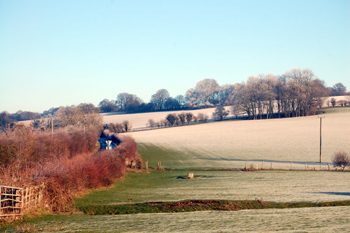
Pedley Hill January 2010
Landscape
Volume III of The Victoria County History for Bedfordshire was published in 1912. At that date the parish contained 3,033 acres of which 1,252 were arable, 571 permanent grass and 190 acres were woodland. Lying in the Chilterns the land rises from 400 feet in the south to 700 feet above sea level in the north. The church is 625 feet above sea-level, The Bell public house is 575 feet and the Holywell housing estate averages between 610 and 630 feet above sea-level. The lowest point of Valley Road is 585 feet above sea-level, Barwythe Hall is 620 feet and the junction of Valley Road with Common road lies at 615 feet above sea-level.
Studham village lies in the centre of the civil parish which also contains a number of hamlets including: Clement's End (in the east bordering the Hertfordshire civil parish of Markyate); Holywell (in the north bordering the civil parish of Whipsnade and close to Kensworth Common) and Hudnall Corner (in the south-west bordering the hamlet of Hudnall in the Hertfordshire civil parish of Little Gaddesden).
The solid, or underlying, geology is a type of chalk characterised as Lewes Nodular Chalk Formation with Seaford Chalk Formation. This was laid down between 84 and 94 million years ago in the warm, shallow seas of the Cretaceous Period. The superficial geology, laid down in the last two million years is chalk with flints though there are some bands of a mixed sand, gravel, silt and clay called head along current and old watercourses.
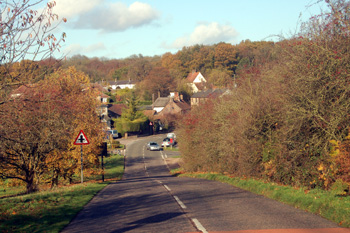
The main part of the village seen from the south November 2009
Name
The name Studham has the meaning of an inclosure or settlement where horses are bred (i.e. a stud). The name has had a few variations over the years:
- Stodham: 1053-1526;
- Estodham: 1086;
- Stodeham: 1286-1491;
- Studham: 1329 to date;
- Stadham: c. 1750.
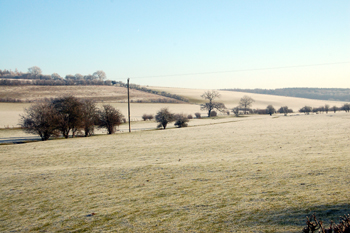
Looking towards the southernmost point in the county January 2010
Administrative History
Studham is the southern-most parish in Bedfordshire, surrounded by Hertfordshire to the east, south and west (the Hertfordshire portion of Caddington, Markyate, Great Gaddesden and Little Gaddesden respectively) and Buckinghamshire along a small portion of the western boundary (Edlesborough). It is bordered by another Bedfordshire parish only to the north where it borders Whipsnade.
It is an ancient parish. Not surprisingly the parish had, until recently, a split identity between Bedfordshire and Hertfordshire, partly in the Manshead Hundred of Bedfordshire and partly in the Hitchin and Pirton Hundred of Hertfordshire. Until the 13th century it also had, somewhat bizarrely, an outlying chapelry at Astwick, many miles to the north east between Biggleswade and Stotfold. A part of Studham on the Hertfordshire side of the border was transferred to Bedfordshire in 1844.
Another outlying part of Studham extended east from Kensworth (then in Hertfordshire) and was known as Humbershoe. This became a separate civil parish (still in Bedfordshire) in 1866 but was abolished in 1897 and used, with the Hertfordshire part of Caddington, Flamstead [Hertfordshire] and an outlying piece of Houghton Regis, to create the Hertfordshire civil parish of Markyate. Humbershoe began at a point north of Manor Farm (now, interestingly, the boundary between LU6 and AL3 postcodes) and ran down the middle of Watling Street (now High Street in Markyate itself) before veering west along Buckwood Road (see the map of the county boundary in Markyate in 1880). Thus the west side of Markyate High Street and the north side of Buckwood Road along with Cock Lane and New Street were in the Bedfordshire portion of Studham. This included the sites of the modern roads of: Albert Street; Becks Close Cavendish Road; Cowper Court; Cowper Rise; Cowper Road; Grange Close; North Court; Old Vicarage Gardens; Park View Drive and Wesley Road.
The county boundary in the main parish of Studham then ran more or less east-west along the "neck" where the arrowhead shaped portion of the modern parish juts south (see the map of the main village in 1880 where the thick black line represents the parish boundary). Thus the majority of the people lived in the Bedfordshire section whilst the bulk of the land fell in Hertfordshire.
The split between the two counties was officially recogised in 1894 with separately constituted civil parishes of Studham in each county. This strange situation was remedied in 1897 when the Hertfordshire civil parish was transferred to Bedfordshire and absorbed into the new Bedfordshire civil parish of Studham. In 1907 parts of Studham were exchanged for parts of the Hertfordshire parish of Great Gaddesden.
The South Bedfordshire (Parishes) Order 1985 transferred quite a large area of land, including Whipsnade Zoo and the chalk cut White Lion figure from Studham to Whopsnade. The smaller areas of Byslip Wood and Heath Wood and an area just south of Buckwood Lane between Holywell and Oldhill Wood housing estates were also transferred [MCDP87/5].
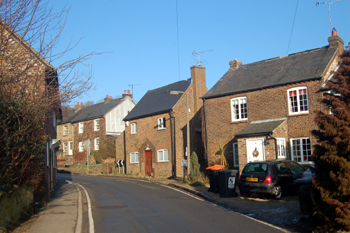
Dunstable Road looking north January 2010
Population
The population of Studham rose steadily in the first part of the nineteenth century, peaking in 1861 then, like many rural parishes, declining as agricultural mechanisation took away jobs in the countryside, forcing a move to urban areas. The low point for population was reached in 1921 and numbers increased sharply during the latter part of the 20th century with the growth of the residential development at Holywell. The population is now nearly three times the level in 1801.
- 1801: 334;
- 1811: 467;
- 1821: 536;
- 1831: 590;
- 1841: 580;
- 1851: 668;
- 1861: 663;
- 1871: 641;
- 1881: 654;
- 1891: 522;
- 1901: 317;
- 1911: 320;
- 1921: 314;
- 1931: 339;
- 1951: 591;
- 1961: 760;
- 1971: 884;
- 1981: 1,128;
- 1991: 1,160;
- 2001: 1,118;
- 2011: 1,128.
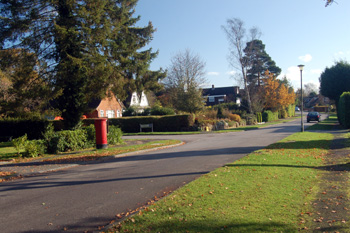
Holywell Road November 2009